The notion that a single help desk tool can handle all your customer service needs is outdated. Modern customers expect instant, personalized support across multiple channels, and the right customer service tools make this possible.
Today’s customers switch between email, live chat, social media, and phone calls within the same conversation. If your customer support team can’t keep up, customers will find a business that can.
So here’s the thing:
Your team needs more than a basic ticketing system. You need customer service tools to track response times, automate routine tasks, provide context for customer data, and integrate with existing workflows.
Fortunately, we’ve done the research for you.
In this article, we’ll discuss 17 of the most effective customer service tools available. From AI-powered automation to industry-specific solutions, we’ve listed top customer service tools to help your team deliver exceptional customer experiences.
Let’s get started.
Your customers have more choices than ever before. They can switch to a competitor with a few clicks, and a poor customer service experience can drive them away faster than you might think.
Research shows that 73% of consumers will leave after multiple bad experiences. In fact, 56% of customers will simply ‘ghost’ you, as they rarely complain about negative customer service experiences.
Image via Coveo
Selecting the best customer service tools is not just about reducing your churn rate —. These tools directly impact your bottom line.
Customer service teams using modern platforms experience faster response times, higher customer satisfaction scores, and better agent productivity.
When your support teams can access customer data instantly, automate routine tasks, and collaborate effectively, they resolve customer issues faster and deliver better experiences.
Today’s customers expect customer service agents to know their history across all touchpoints. They want consistent quality service on every channel, whether they contact you via email, live chat, or phone.
That’s why omnichannel support tools matter. By unifying communication channels and customer data, these customer service tools give your team the context they need to deliver fast, personalized service.
Speed and fast resolutions are no longer a bonus — it’s expected. Customer service tools that track and improve response times help teams meet these expectations while identifying bottlenecks before they become bigger problems.
The customer support industry is also shifting toward AI and automation. Customer service teams that embrace these technologies can handle more customer inquiries while focusing human agents on complex, high-value customer interactions.
We evaluated various customer service tools based on features that are valuable to customer support teams. These include:
The right customer service software can make the difference between losing customers and creating loyal advocates. To help you find the perfect fit, we’ve curated a list of the 17 best customer service tools.
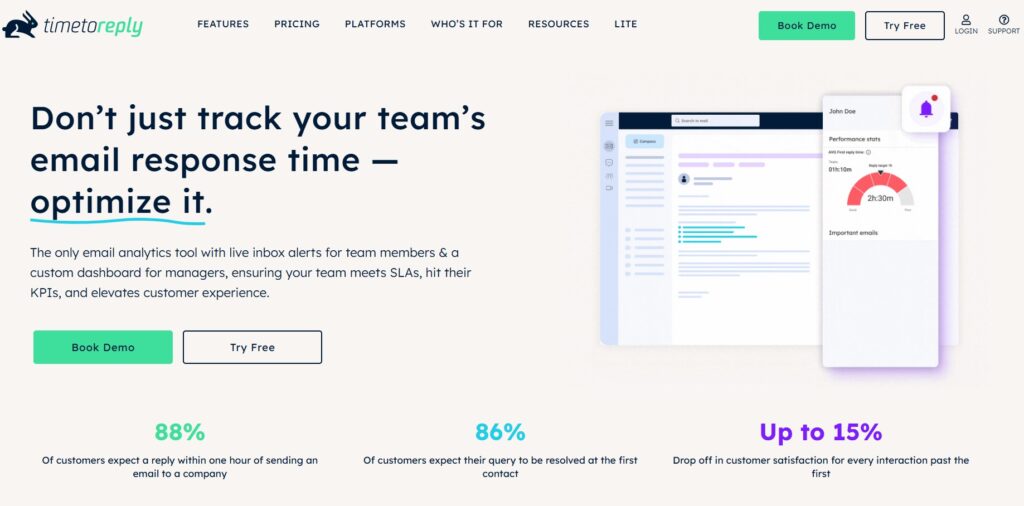
Image via timetoreply
Timetoreply specializes in email analytics and response-time optimization, designed specifically for customer-facing teams that need to track and improve their email performance.
Rather than replacing existing customer service tools, timetoreply works as a performance enhancement layer on top of current email systems.
The platform addresses a critical gap in most customer service tools: the ability to measure and optimize email response times with precision.
timetoreply offers real-time coaching, KPI tracking, and detailed analytics that help teams understand how, when, and why response times vary across different scenarios.
Key features
Pros
Cons
Pricing

Image via timetoreply
Tool level
Usability
Pro tip: Use leaderboards and trend reporting to motivate distributed teams across different time zones.
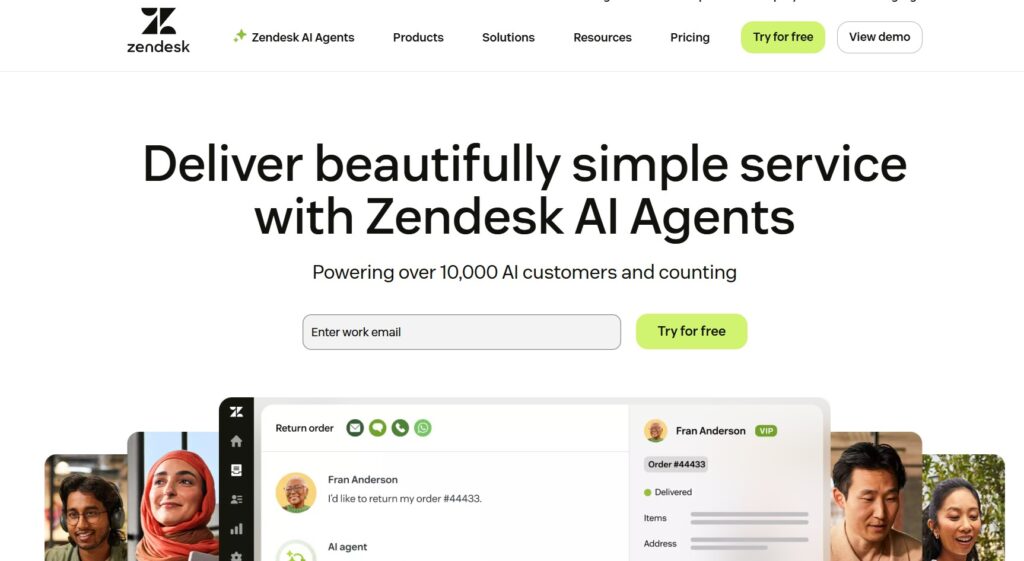
Image via Zendesk
Zendesk is a widely used platform for omnichannel customer support. Currently serving over 10,000 companies worldwide, this customer support tool has a comprehensive platform that unifies customer conversations across all channels.
It’s one of the customer service tools that excel at creating seamless experiences. Customers can start conversations via email, continue through live chat, and finish over the phone without losing context.
The platform’s strength lies in its ability to scale from small startups to enterprise customer service operations without losing functionality.
Teams can begin with basic ticket management and gradually add AI agents, advanced workflows, and custom integrations as their needs evolve.
Key features
Pros
Cons
Pricing

Image via Zendesk
Tool level
Usability
Pro tip: Start with the Suite Team plan and enable AI agents to handle routine customer inquiries like password resets and order status checks. This frees up human agents for complex problem-solving while you learn the platform’s advanced features.
Also Read:
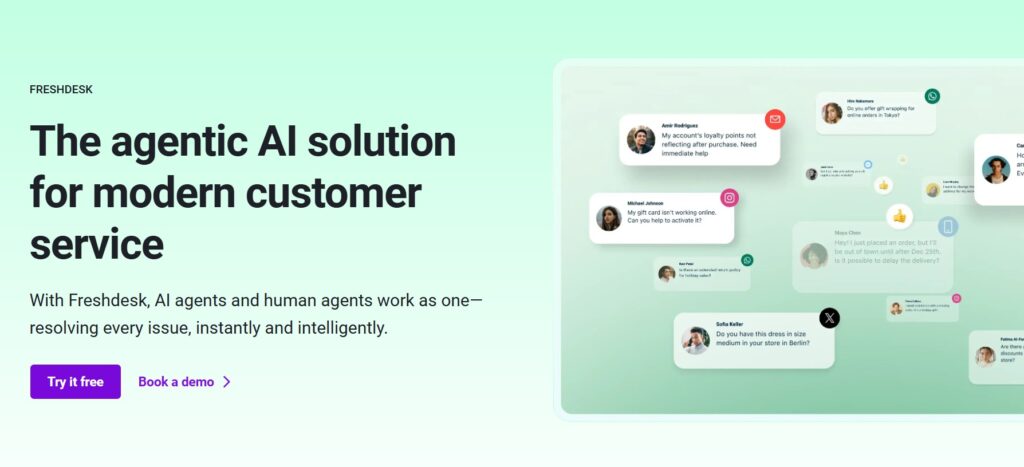
Image via Freshdesk
Freshdesk positions itself as the user-friendly alternative to more complex customer service tools. It focuses on intuitive design and smart automation features that help teams deliver better customer support without extensive training.
This customer service tool makes it remarkably easy for new users to get started while providing sophisticated features that scale with growing customer support needs.
What sets Freshdesk apart is its commitment to reducing the complexity that often overwhelms customer support teams when adopting new customer service tools. The interface feels natural and logical, with features that match how customer support teams actually work.
Key features
Pros
Cons
Pricing

Image via Freshdesk
Tool level
Usability
Pro tip: Leverage Freddy AI’s sentiment analysis to automatically prioritize support tickets from frustrated customers.
Also Read:
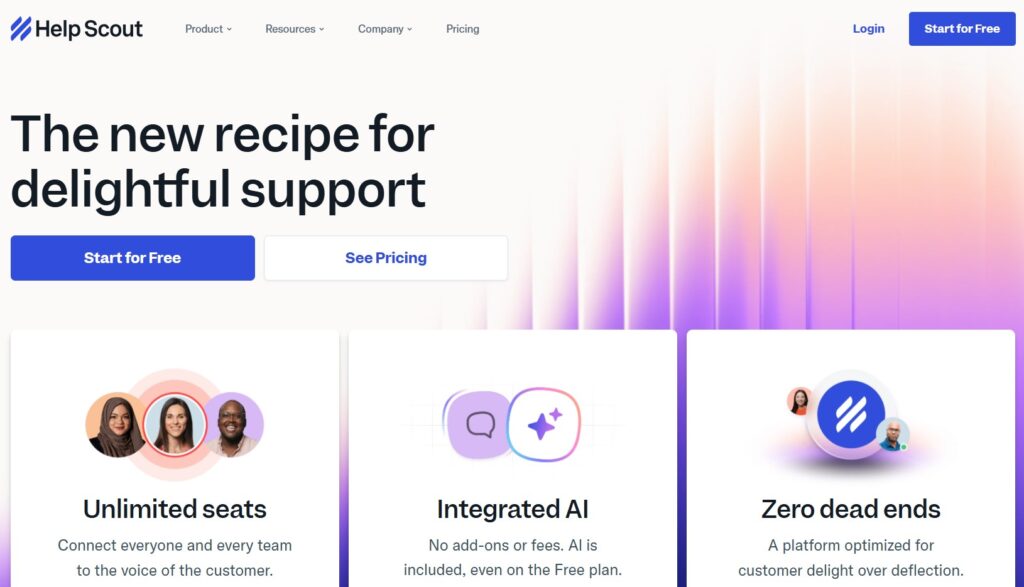
Image via Help Scout
Help Scout emphasizes the human side of customer service. It’s one of the customer service tools designed specifically for customer service teams that need both personal connections and efficient ticket processing capabilities.
Customer service tools like Help Scout feels more like an enhanced email system than traditional help desk software. This makes it immediately familiar to teams already comfortable with inbox management workflows.
The philosophy behind Help Scout centers on treating customers as individuals rather than ticket numbers. Every feature supports this goal, from customer profiles that surface relevant context to conversation threading that maintains relationship continuity.
Key features
Pros
Cons
Pricing

Image via Help Scout
Tool level
Usability
Pro tip: Use customer profiles to personalize every response with relevant context about previous purchases, customer support history, and preferences.
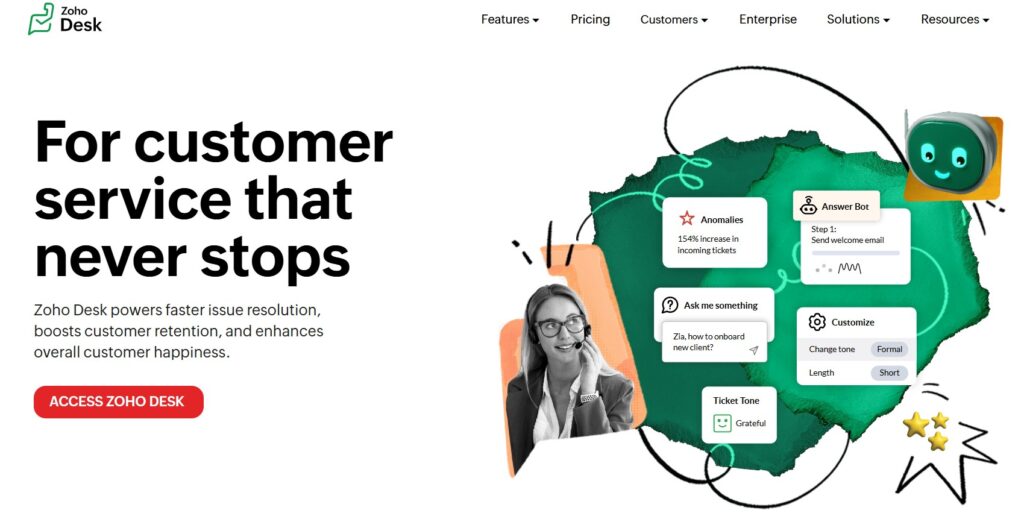
Image via Zoho Desk
Zoho Desk brings AI-powered insights to customer service while integrating deeply with the broader Zoho business ecosystem. This customer service tool stands out for its predictive capabilities and comprehensive analytics.
The platform’s integration with other Zoho applications creates unique opportunities for businesses that already use Zoho CRM, Projects, or other tools within the suite.
This is one of the customer service tools that allows support teams to access customer data and business context that would typically require switching between multiple systems.
Key features
Pros
Cons
Pricing

Image via Zoho Desk
Tool level
Usability
Pro tip: Use Zia AI to predict which customers are likely to become dissatisfied based on their interaction patterns and communication tone.
Also Read:
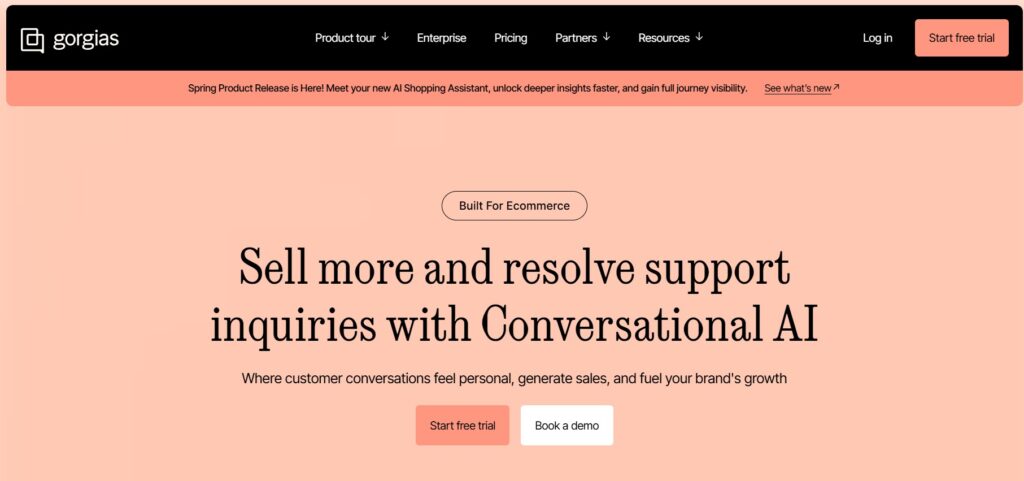
Image via Gorgias
Gorgias focuses exclusively on ecommerce customer service, built specifically for online retailers who need to connect customer support conversations directly to revenue impact.
While most customer service tools treat customer support as a cost center, Gorgias positions customer service as a profit center. It provides features that help support teams drive sales while resolving issues.
The platform’s focus on ecommerce means every feature is designed with online retail workflows in mind. Support agents can see order history, shipping status, and customer lifetime value directly in conversation views, which adds more context.
Key features
Pros
Cons
Pricing

Image via Gorgias
Tool level
Usability
Pro tip: Set up automation rules to instantly handle order status inquiries, return support requests, and shipping questions.
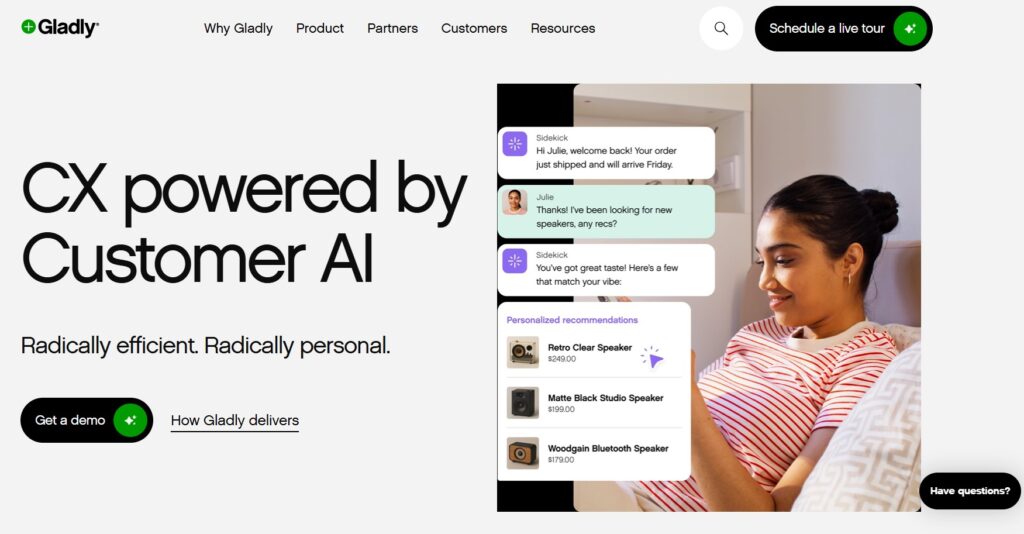
Image via Gladly
Gladly brings a new spin to customer service by organizing conversations around people rather than tickets. This creates a more natural and personal experience for both customers and agents.
This approach sets Gladly apart from traditional customer service tools that fragment customer interactions across multiple tickets that lose valuable context in the process.
This person-centric approach changes how support teams work. Agents can view complete customer relationships at a glance, understand customer preferences and history, and provide personalized customer service.
Key features
Pros
Cons
Pricing
Gladly only offers custom pricing but provides a demo and a product tour to test-run their services.
Tool level
Usability
Pro tip: Train agents to review the complete customer timeline before responding to any inquiry to allow for a more personalized service.
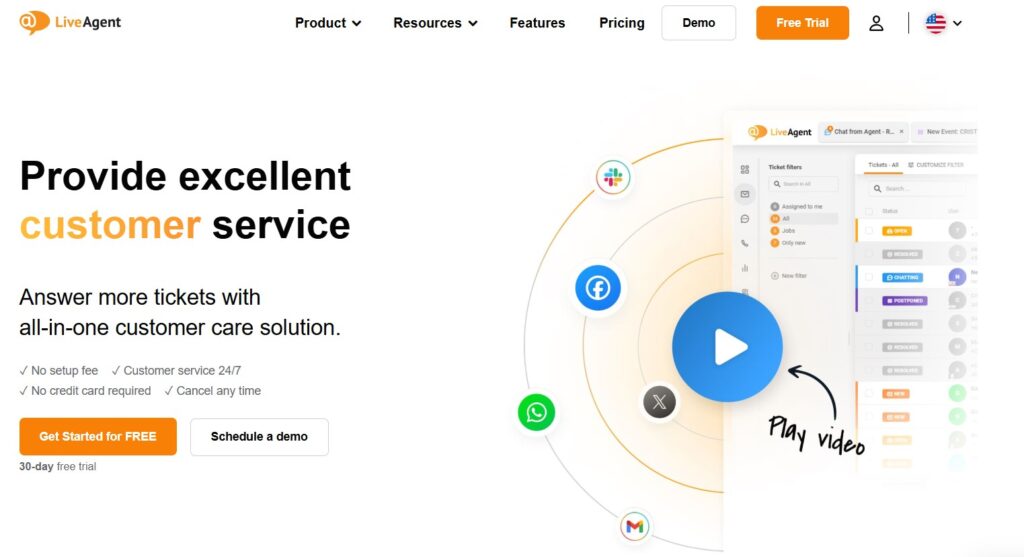
Image via LiveAgent
LiveAgent combines comprehensive customer service capabilities with full call center software functionality. This allows it to offer one of the most complete feature sets available in a single customer service tool.
Unlike some customer service tools, LiveAgent offers a comprehensive solution. This includes everything from basic email ticket management to advanced phone system integration, all in one unified platform.
Teams can handle phone calls, live chats, emails, and social media messages from a single interface while maintaining context across all channels.
Key features
Pros
Cons
Pricing

Image via LiveAgent
Tool level
Usability
Pro tip: Use the gamification features to create friendly competition among agents with leaderboards for response times, customer satisfaction scores, and resolution rates.
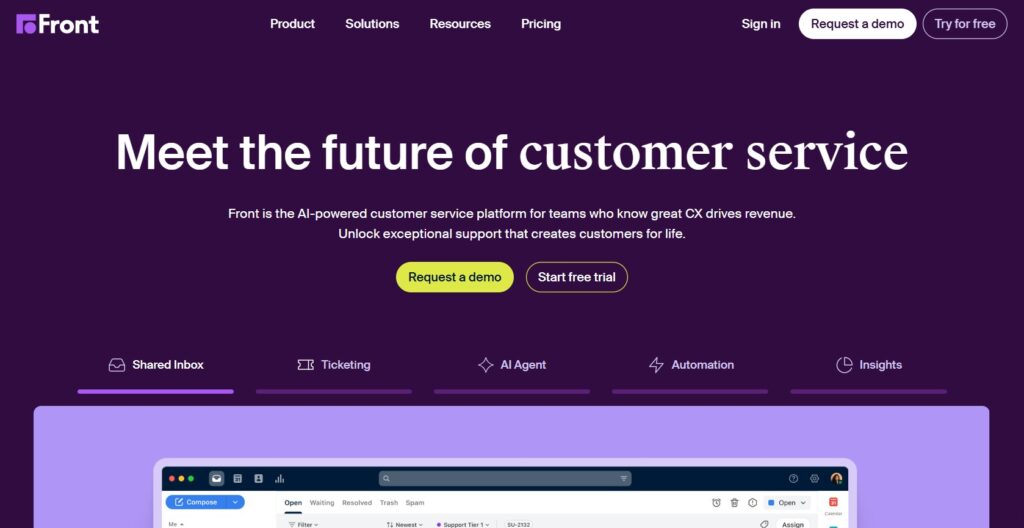
Image via Front
Front reconstructs team email into a collaborative workspace where customer conversations become shared responsibilities rather than individual silos.
As one of the most collaboration-focused customer service tools available, Front excels at breaking down barriers between your customer support, sales team, and other customer-facing teams.
Front turns every conversation into a shared team asset. It also has assignment and workflow features to ensure accountability and prevent anything from slipping through the cracks.
Key features
Pros
Cons
Pricing

Image via Front
Tool level
Usability
Pro tip: Use internal comments and @mentions to collaborate on complex customer issues without exposing internal discussions to customers.
Also Read:
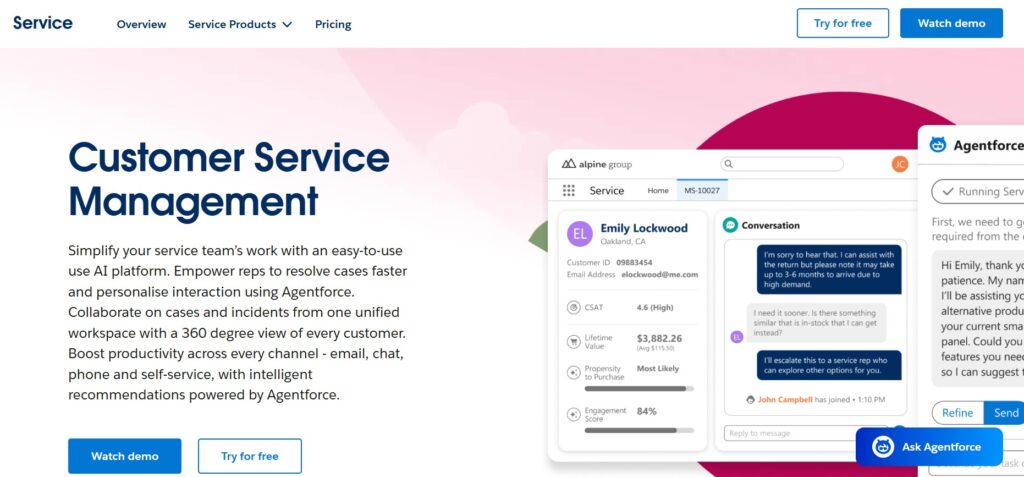
Image via Salesforce Service Cloud
Salesforce Service Cloud offers enterprise-level customer service with robust CRM integration. Its advanced AI features, powered by Einstein and Agentforce, help streamline and personalize support.
Service Cloud provides the flexibility and power needed for organizations with complex customer service needs. It also maintains enterprise-grade security and compliance standards.
For organizations already using Salesforce or those requiring enterprise-level customization and security, Service Cloud provides unmatched flexibility and power.
Key features
Pros
Cons
Pricing

Image via Salesforce Service Cloud
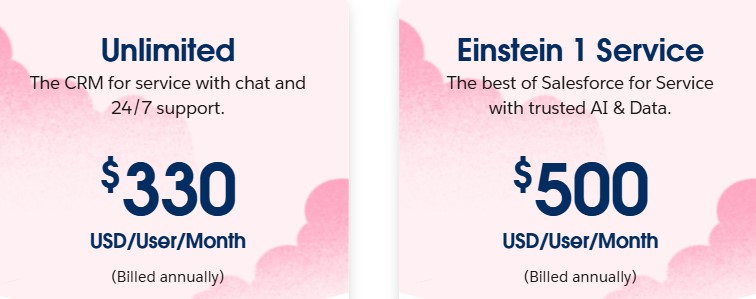
Image via Salesforce Service Cloud
Tool level
Usability
Pro tip: Start with Einstein Case Classification to automatically route incoming cases to agents with the right skills and experience to improve first-contact resolution rates.
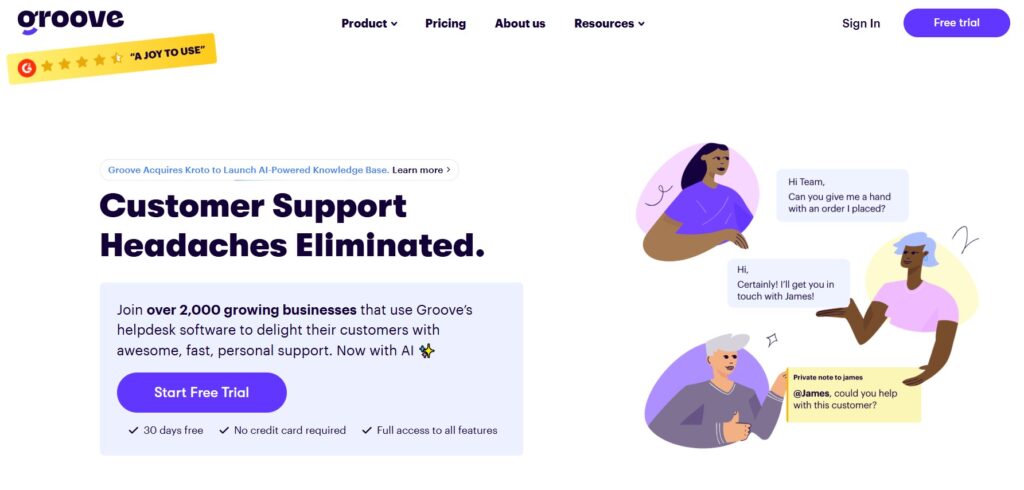
Image via Groove
Groove simplifies customer service by providing a Gmail-style interface that feels immediately familiar to most users. It’s one of the most straightforward customer service tools without complex features.
The beauty of Groove lies in its simplicity and focus on core functionality. Rather than trying to be everything to everyone, the platform excels at email-based customer service.
Key features
Pros
Cons
Pricing

Image via Groove
Tool level
Usability
Pro tip: Use the shared drafts feature to maintain consistency in team responses by creating templates for common scenarios.
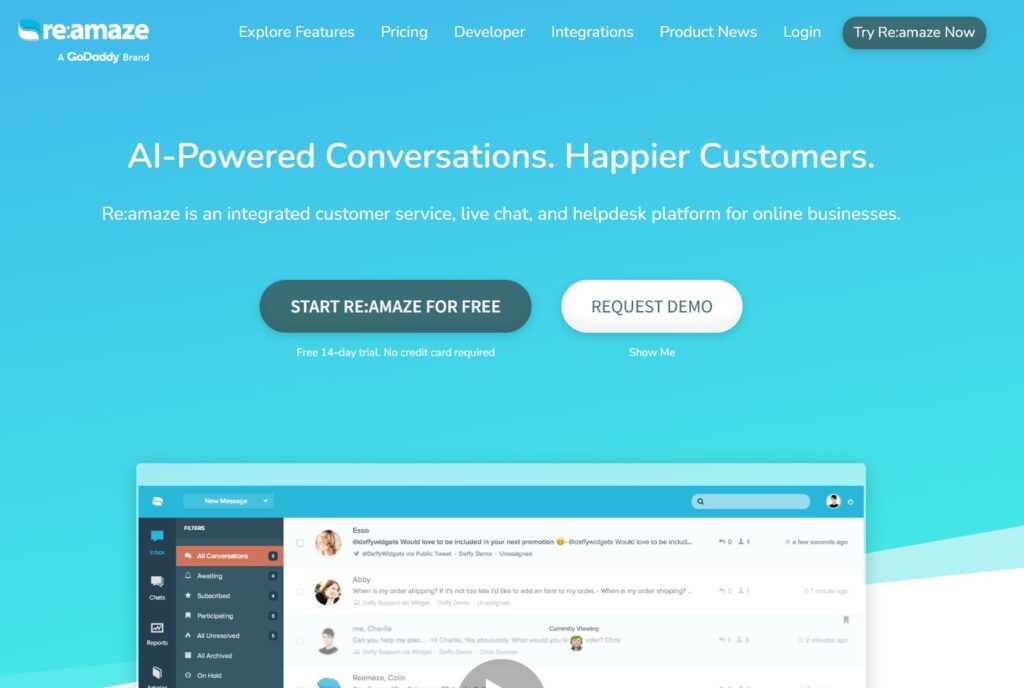
Image via Re:amaze
Re:amaze specializes in multi-brand customer service management, designed specifically for agencies and businesses that support multiple brands or clients from a single platform.
Few customer service tools handle multi-brand scenarios as elegantly as Re:amaze. The platform maintains separate brand identities while streamlining customer service operations.
Managing multiple brands often requires separate customer service tools or complex workarounds that compromise efficiency. Re:amaze solves this problem by providing native multi-brand support, keeping everything organized.
Key features
Pros
Cons
Pricing

Image via Re:amaze
Tool level
Usability
Pro tip: Use proactive messaging rules to engage website visitors before they encounter problems.
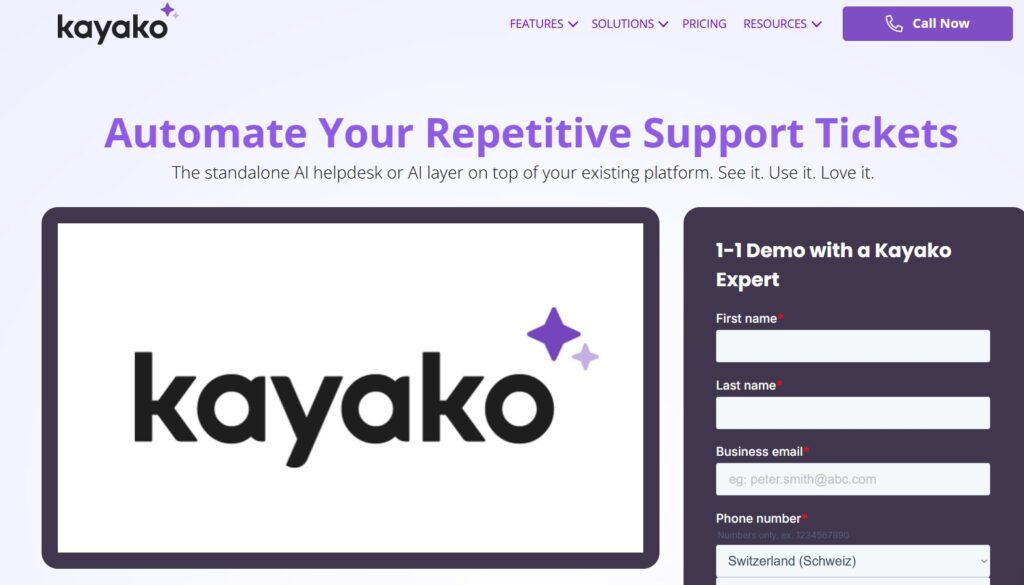
Image via Kayako
Kayako takes a customer journey-focused approach to support, organizing customer interactions around the complete service experience rather than individual tickets or issues.
This journey-centric philosophy differentiates Kayako from typical customer service tools that focus solely on resolving individual problems without considering the broader customer experience.
By tracking and analyzing complete customer journeys, teams can identify patterns, prevent recurring issues, and create more satisfying interactions that build long-term loyalty.
Key features
Pros
Cons
Pricing
Essential and Enterprise tiers with custom pricing
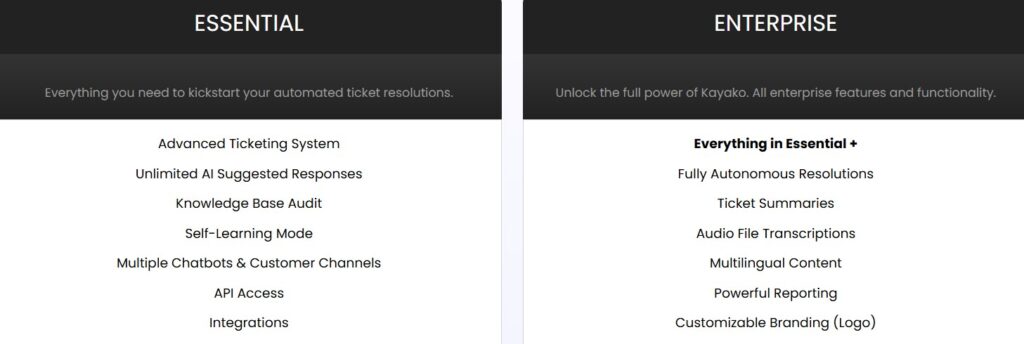
Image via Kayako
Tool level
Usability
Pro tip: Use journey insights to identify common points where customers struggle or abandon their goals.

Image via Richpanel
Richpanel focuses specifically on ecommerce customer service, combining AI automation with comprehensive self-service features. It’s one of the customer service tools that aim to reduce support costs while improving customer satisfaction.
Built exclusively for online retailers, Richpanel addresses ecommerce needs that general-purpose customer service tools simply cannot handle effectively.
Richpanel understands that ecommerce customer service has unique requirements around order management, returns, shipping, and product support. And so, every feature is designed with these workflows in mind.
Key features
Pros
Cons
Pricing

Image via Richpanel
Tool level
Usability
Pro tip: Implement the self-service portal to handle common ecommerce customer queries like order tracking, return support requests, and shipping updates automatically.
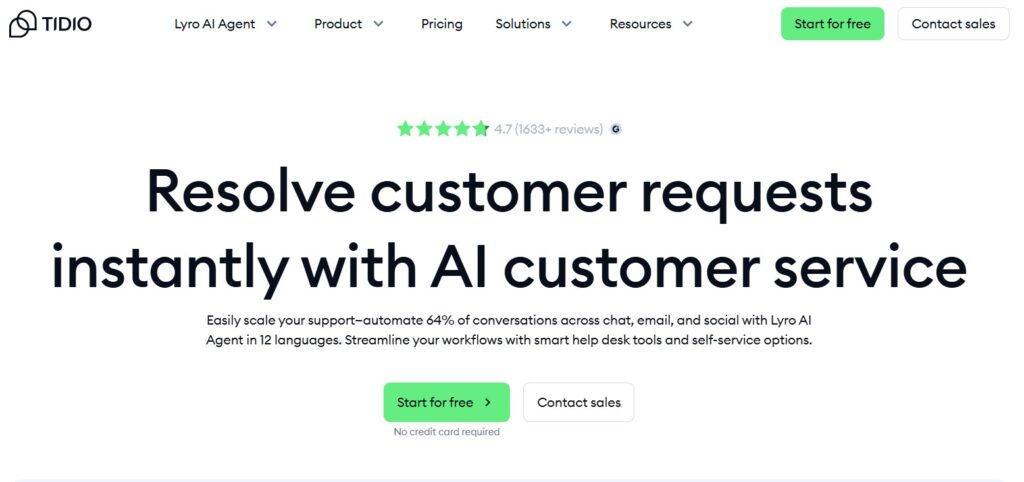
Image via Tidio
Tidio combines live chat, chatbots, and basic customer service features into an affordable package designed for small businesses and ecommerce stores.
Rather than competing directly with comprehensive customer service tools, Tidio excels at website engagement and lead generation while providing fundamental support capabilities.
Key features
Pros
Cons
Pricing

Image via Tidio
Tool level
Usability
Pro tip: Use chatbots to qualify leads and handle basic inquiries during off-hours, then transfer qualified prospects to human agents during business hours.
Also Read:
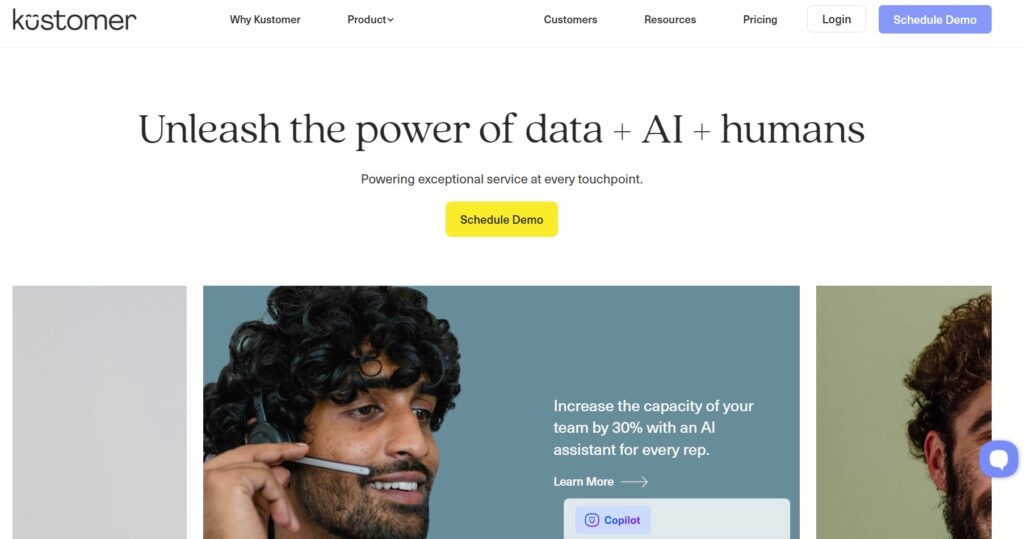
Image via Kustomer
Kustomer integrates CRM functionality with customer service capabilities. It’s one of the customer service tools that creates a comprehensive view of each customer relationship beyond individual support interactions.
This integrated approach makes Kustomer particularly valuable compared to standalone customer service tools that lack deep customer relationship management connectivity.
It’s also ideal for businesses with long sales cycles, where support interactions significantly impact renewals, upselling, and customer lifetime value. The platform helps teams understand immediate support needs and broader business relationships.
Key features
Pros
Cons
Pricing
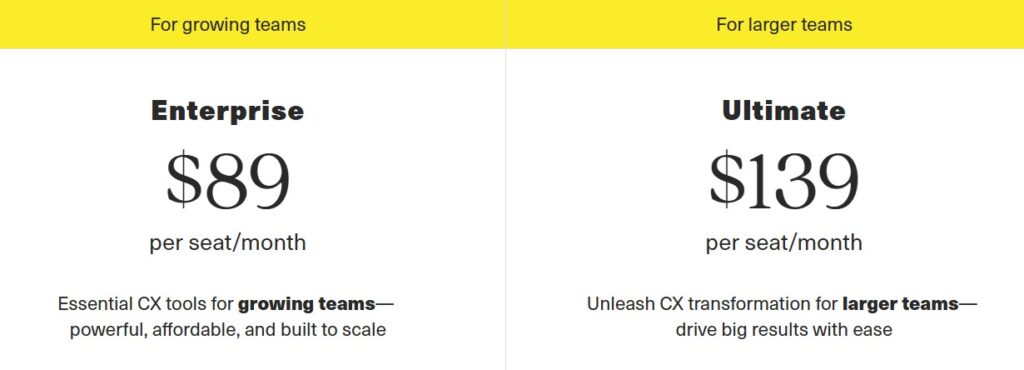
Image via Kustomer
Tool level
Usability
Pro tip: Use the customer timeline to understand the complete relationship history before responding to any inquiry.
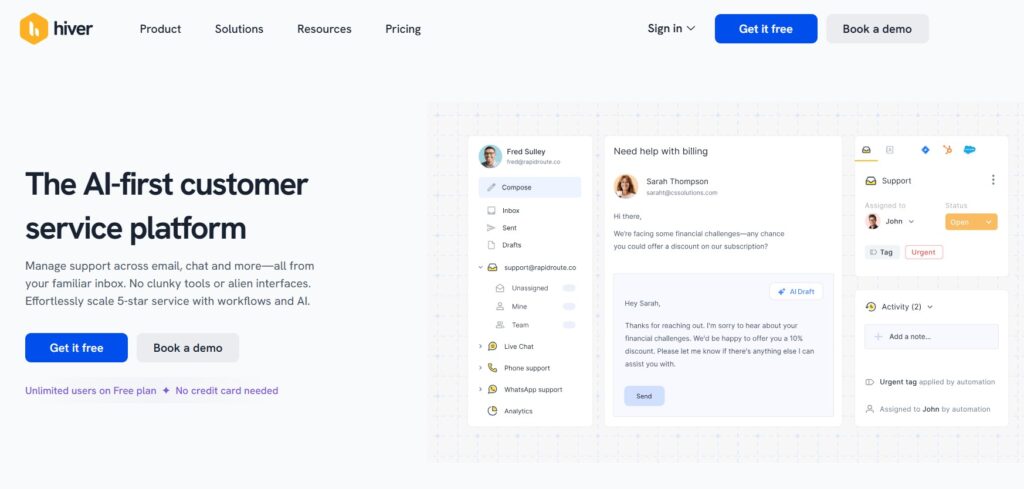
Image via Hiver
Hiver upgrades Gmail into a collaborative customer service platform without requiring teams to learn new software or change existing workflows.
This Gmail-first approach eliminates the adoption barriers that often prevent teams from successfully implementing traditional customer service tools.
Since agents continue working in Gmail, they can become productive immediately while gaining powerful collaboration and tracking capabilities that foster quality service and team coordination.
Key features
Pros
Cons
Pricing

Image via Hiver
Tool level
Usability
Pro tip: Use collision detection and internal notes to coordinate team responses discreetly, ensuring customers do not see internal discussions.
Also Read:
1. What are customer service tools?
Customer service tools are software platforms and applications that help businesses manage, track, and improve their customer support operations. These customer service tools typically include features like ticketing systems, live chat, knowledge bases, and analytics to streamline communication between customers and support teams.
2. What is the best customer service tool?
The best customer service software depends on your specific needs, team size, and budget. Zendesk excels in comprehensive omnichannel support, while Help Scout is ideal for email-focused teams that prioritize personal connections.
Small businesses often prefer Groove or Tidio for simplicity, while enterprises typically choose Salesforce Service Cloud or Kustomer for advanced features. For teams specifically focused on email response time optimization, timetoreply offers specialized analytics and performance tracking capabilities.
3. Which tool is most useful in helping customer service?
For most teams, the most effective customer service tools integrate multiple communication channels with robust analytics and automation. Platforms like Zendesk, Freshdesk, and Salesforce Service Cloud offer comprehensive feature sets that cater to a wide range of support scenarios.
However, specialized customer service tools like timetoreply for email analytics or Gorgias for ecommerce can be more valuable than general platforms if they match your primary support channel and business model perfectly.
4. What features should I look for in a customer service tool?
Essential features to look for include:
Advanced features to consider are:
Select the customer service tool that best meets your current needs, while ensuring the platform can scale as your team expands.
5. What are four examples of customer service?
Four common examples of customer service include:
Modern customer service also includes proactive outreach, social media support, and AI-powered chatbots that handle routine inquiries automatically while escalating complex issues to human agents.
Also Read:
The right customer service tools make a real difference in both agent performance and customer retention. Your choice of platform directly impacts response times, customer satisfaction, and your team’s ability to scale efficiently as your business grows.
Take time to audit your current stack and identify gaps in support coverage or response tracking. Consider whether your tools work together seamlessly or create friction that slows down your team.
The best customer service tools seamlessly integrate with your existing workflows, providing the insights you need to continually improve.
Whether you need comprehensive omnichannel support or specialized functionality, investing in the right customer service tools fine-tunes how you connect with customers and build lasting relationships.
Ready to improve your email response times? Start tracking your team’s performance with timetoreply and see immediate improvements in customer satisfaction today!
Get live inbox alerts and reply quickly to customer emails with timetoreply